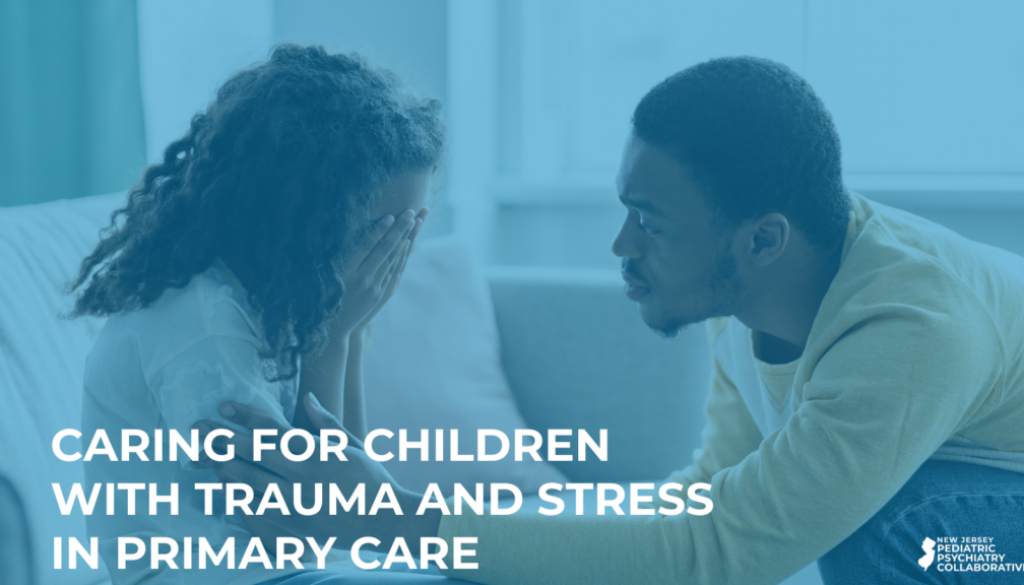Caring for Children with Trauma and Stress in Primary Care
By Saranga Bhalla, DO
Traumatic experiences in children and adolescents are common. Almost 50% of American children and adolescents have experienced at least one potentially traumatic event (1). Examples of childhood traumas include bullying, neglect, loss of a loved one, school or community violence, abuse or assault, loss or displacement due to a natural disaster, and refugee experiences. For many children, medical procedures, invasive treatments, ER visits, or injuries can be traumatic as well. Pediatricians are in a unique position for the prevention of trauma and the early identification and treatment of it since they are on the front lines of caring for children. They also have the natural skills that are compatible with trauma-informed care since they are already family-centered and comfortable discussing anticipatory guidance. According to The National Child Traumatic Stress Network, the need for mental health treatment in the future decreases with early intervention and improves overall health status.
Caring for children affected by trauma and stress in primary care settings requires a comprehensive, trauma-informed approach. But what is trauma-informed care (TIC)? The National Child Traumatic Stress Network defines TIC in healthcare as a medical approach that focuses on recognizing and responding to the effects of trauma. Goals include preventing re-traumatization and promoting healing.
Primary intervention focuses on anticipatory guidance and building protective factors.
Secondary prevention includes screening for trauma symptoms, providing education to children and their caregivers, and implementing early therapeutic interventions such as providing anticipatory guidance.
Similar to other medical conditions, TIC includes purposeful triage, history-taking, surveillance and screening, examination, differential diagnosis, sharing of the diagnosis, and management, which may include office-based anticipatory guidance, referral, psychopharmacology, and/or follow-up or recommendations (2).
| F | Frets (anxiety and worry) and fears |
| R | Regulation difficulties (disorders of behaviors or emotions; hyperactive, impulsive, easily becomes aggressive or emotional; inattentive) |
| A | Attachment challenges (insecure attachment relationships with caregivers); poor peer relationships |
| Y | Yawning (sleep problems) and yelling (aggression, impulsivity) |
| E | Educational and developmental delays (especially cognitive, social-emotional, and communication) |
| D | Defeated (hopeless), depressed, or dissociated (separated from the reality of the moment, lives in own head) |
(The most common symptoms of trauma exposure can be remembered by the mnemonic “FRAYED.” Adapted from Forkey H, Griffin J, Szilagyi M. Childhood Trauma and Resilience: A Practical Guide. Itasca, IL: American Academy of Pediatrics; 2021.)
Parents may also be affected by their child’s trauma. Common symptoms include emotional symptoms such as anxiety, guilt, or anger; behavioral symptoms such as substance use and social withdrawal; and physical symptoms such as exacerbation of their own health issues or sleep disturbances. Recognizing these signs is crucial for early intervention.
Currently, there are no standardized and validated screening scales. Tools such as the Adverse Childhood Experiences (ACE) Questionnaire and the Childhood Trauma Questionnaire (CTQ) can be utilized to identify children at risk. Parental ACE screening may afford the opportunity to support caregivers.
While post-traumatic symptoms are common after a trauma, most children do not go on to develop Acute Stress Disorder (ASD) or Post-traumatic Stress Disorder (PTSD). The subjective experience of the trauma is a much more important predictor of ASD or PTSD than the objective severity of the trauma.
The UK’s National Institute for Health and Care Excellence (NICE) guidelines for PTSD in children recommend “watchful waiting” if symptoms are mild and have been present for 1 month or less. Support should be given to the child and caregiver(s) and a follow-up appointment should be scheduled 1 month later. If symptoms are severe or persist after 1 month, a referral for Trauma-Focused Cognitive Behavioral Therapy (TF-CBT) should be made. The goal of TF-CBT is to help children and their caregiver(s) process and cope with trauma while strengthening their support systems. Other treatment recommendations include Parent-Child Interaction Therapy (PCIT), which focuses on the parent-child relationship and addresses behavioral issues. Lastly, psychopharmacological interventions should be considered for co-occurring conditions such as depression or anxiety. Referral to a mental health specialist or child psychiatrist is warranted when symptoms persist or progressively worsen despite primary care interventions, if there is significant impairment in daily functioning, or if there are safety concerns about the child or others.
Several organizations offer resources and training for pediatricians:
- National Child Traumatic Stress Network (NCTSN) – Provides toolkits and educational materials on pediatric medical traumatic stress.
- American Academy of Pediatrics (AAP) – Offers guidance on trauma-informed care and mental health resources
- Substance Abuse and Mental Health Services Administration (SAMHSA) – Provides a practical guide for implementing a trauma-informed approach
By adopting a trauma-informed approach, primary care providers can significantly impact the health and well-being of children and their families affected by trauma.
REFERENCES:
- https://www.samhsa.gov/mental-health/trauma-violence/child-trauma
- (1) Copeland WE , Keeler G , Angold A , Costello EJ . Traumatic events and posttraumatic stress in childhood. Arch Gen Psychiatry. 2007;64(5):577–584
- Bethell C, Davis MB, Gombojav N , Stumbo S , Powers K . Issue brief: a national and across-state profile on adverse childhood experiences among children and possibilities to heal and thrive. 2017.
- (2) Heather Forkey, MD, FAAP; Moira Szilagyi, MD, PhD, FAAP; Erin T. Kelly, MD, FAAP, FACP; James Duffee, MD, MPH, FAAP; The Council on Foster Care, Adoption, and Kinship Care, Council on Community Pediatrics, Council on Child Abuse and Neglect, Committee on Psychosocial Aspects of Child and Family Health; Trauma-Informed Care
- Adapted from Forkey H, Griffin J, Szilagyi M. Childhood Trauma and Resilience: A Practical Guide. Itasca, IL: American Academy of Pediatrics; 2021
- Creating Trauma-Informed Child-Serving Systems: Pediatric Health Care- presentation by Nancy Kassam-Adams, Ph.D.
Author Profile:


Saranga Bhalla, DO
Board-Certified Child & Adolescent, and Adult Psychiatrist
Princeton Mental Health, LLC.




